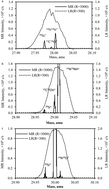Aluminum alloy is frequently used as component material in research nuclear reactors. Thermal neutron irradiation of aluminum causes it to undergo transmutation to silicon. The production of silicon inside of aluminum alloy changes its material and mechanical properties. Furthermore, the concentration and the isotopic composition of the radiogenic silicon provides information on the irradiation history of the material and operation history of the reactor both of which are important to nuclear forensics and nuclear archaeology. An analytical method has been developed to determine the concentration and isotopic composition of radiogenic silicon using sector field ICP-MS. Applying a mass resolution of 3000 avoided severe spectral interferences from poly-atomic and doubly charged ion species generated from the solution matrix observed using lower resolution mass spectrometers. The measured content of radiogenic silicon in aluminium alloy materials irradiated with known fluence of thermal neutrons agreed well with the theoretically predicted values.
